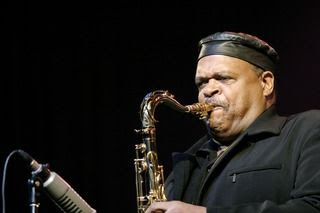John Stubblefield (February 4, 1945 – July 4, 2005) was one of the most highly respected American jazz saxophonist, flautist and oboist of his generation. He played with legendary musicians across the jazz spectrum and left a legacy of quality studio work over more than three decades as a bandleader, studio musician, and go-to saxophonist for live performances and tours.
Stubblefield was from Little Rock, Arkansas, and grew up in a tightly segregated society. His father, a skilled machinist, was a big band fan, but his devout mother considered jazz to be the "devil's music". A piano student from the age of nine, Stubblefield fell in love with the saxophone in his teens and abandoned the piano. He recalled an environment suffused with music, with itinerant blues and gospel performers serenading in his all-black neighbourhood. That experience and the emotionalism of the church flowed into his fiercely declamatory solo style.
 |
| Slomo, Ashley & Stubbleford '68 |
Stubblefield's first paid gigs were on Ninth Street, the focus for black entertainment in Little Rock in his teens. At 17 he joined York Wilburn and the Thrillers, covering everything from jazz to pop, and recording with them in 1962. Following a year on the road with soul singer Solomon Burke, he gained a scholarship to A&ME College in Pine Bluff, Arkansas, and took a music degree, while still playing with touring bands, gospel artists, and with his own modern jazz quintet.
Fully up on Charlie Parker but still wrestling with John Coltrane's innovations, he made for Chicago in 1967 after graduation. There he linked up with the Association for the Advancement of Creative Musicians (AACM), a group of like-minded avant-garde black players. He studied under Muhal Richard Abrams and appeared on Joseph Jarman's landmark 1968 set As If It Were the Seasons.
In 1971 Stubblefield and his wife moved to New York, where he hooked up with the Collective Black Artists (CBA), New York's counterpart to AACM. This led to work with pianist Mary Lou Williams, who recorded several of his compositions. Stubblefield also played with Latin bands, including Tito Puente, and big bands before joining Mingus, in 1972 on alto saxophone, adding oboe, flute and bass-clarinet as required. After five months with the group he and Mingus suffered a falling-out that effectively left Stubblefield blacklisted throughout much of the New York jazz community. He finally landed with Nat Adderley's quintet, resisting Mingus' overtures for him to return to the fold.
Here’s “Twelve for K.D.” from above album.
Briefly a part of a Miles Davis group, Stubblefield also performed with Gil Evans and Abdullah Ibrahim, taught in the Jazzmobile programme, and seems to have been linked, if only briefly, with every modern player of consequence, while running groups of his own - with regular visits to Japan - and recording prolifically.
Stubblefield also served for a time as a jazz ensemble director at the Mason Gross School of the Arts, following the departure of Paul Jeffrey in 1983. He cut his first disc as a leader, Midnight Sun, in 1976 -- subsequent efforts for the Enja and Soul Note labels include 1984's Confessin', 1987's Countin' on the Blues, and 1990's Sophisticatedfunk. Following Mingus' death, his widow Sue assembled the Mingus Big Band in 1992 to carry on her husband's legacy. Stubblefield served as its lead tenor and occasional conductor, and was one of the few band members who had actually played alongside Mingus in his prime. Stubblefield was inducted into the Arkansas Jazz Hall of Fame in 1998.
For all his musical accomplishments, Stubblefield's membership of the Mingus Big Band, including engagements at Ronnie Scott's in London, may have been his finest hour, and would have continued but for the onset of prostate cancer in April 2004. Yet he conducted the orchestra from his wheelchair when they recorded three of his arrangements in October 2004 for the I Am Three album. Thereafter he needed full-time care, but stayed surprisingly upbeat, keeping in touch with friends, much heartened by the support of his family and by visits from Bill Cosby, and Bill Clinton, who held his hand and talked saxophones for an hour.
Stubblefield married his second wife, Katherine, in a hospital ceremony in May. He died July 4, 2005 in The Bonx, New York aged 60. His memorial service at St. Peter’s Church at 54th Street and Lexington in New York City was attended by scores of musicians and included three hours of musical tributes. He was inducted into the Arkansas Black Hall of Fame posthumously in 2007.
(Edited mainly from Guardian obit by Peter Vacher, with help from AllMusic & Wikiipedia.)Here’s a clip of Jeremy Monteiro (p) Eldee Young (bs,vc), Redd Holt (dr), John Stubblefield (ts) O'Donel Levy (g) "live" at Montreux 1988. Although this video concentrates mainly on Eldee Young, this is the only video I can find containing John at the moment. He appears @ 2:39 for a 30 second solo and intermittently throughout the rest of the video.







